ALS Minerals
Mineralogy Capabilities

Facility and Services
ALS Mineralogy is based in Brisbane, Australia and supports the general quantitative mineralogy requirements of external clients and ALS Laboratories in Australia and internationally. The use of this technique adds value to the projects of many international and Australian mining companies.
The ALS Mineralogy service employs the use of nine Mineral Liberation Analyser (MLA) systems to quantitatively analyse mineral samples for a large variety of applications including base metals, mineral sands, iron ores, uranium, rare earth minerals, precious metals and coal & coke samples.
The acquisition of the newest generation Field Emission Gun (FEG) system offers improved capability to detect ultra-fine grains of precious metals whilst the large number of MLA systems enables ALS Mineralogy to support the mineralogy requirements of large exploration and mining projects including geometallurgy.
ALS Mineralogy has access to ALS facilities for crushing, sizing and upgrading of samples. Integration with other ALS Laboratories and metallurgical facilities provides clients with a comprehensive testing service.
The ALS Mineralogy team includes mineralogists and geologists with extensive experience in quantitative mineralogy. We work closely with our clients to ensure the delivery of the highest level of service by providing accurate, relevant and timely data.
Data Output
MLA analysis is rapid but includes thousands of particles, thus ensuring the data is representative of any occurrence. The data can be used to estimate grind sizes required for desired liberation and concentrate grades. The hardness of feed can be linked to the concentration of gangue minerals and the probability of contamination by diluents such as pyrite or minerals bearing penalty elements can be established using the association/locking and liberation data.
MLA systems are also ideally suited to the quantification of precious metals present as disseminated, fine-grains. The grains and their host minerals can be quantified and potential recovery methods assessed to determine the reasons for any losses.
Some examples of the MLA data output include:
• Mineral List (including formulae and elemental percentages)
• Mineral Abundances (Wt%)
• Elemental Distribution of valuable and penalty
• Grain Size Distribution
• Mineral Association, Locking and Liberation
• Theoretical Grade Recovery Curves
• Filtering of Data (e.g. to establish grain size of locked minerals of interest)
• Coloured Mineral Maps provide qualitative data
Clients are provided with a range of reporting options and proprietary software to explore images and data.
Source: http://www.alsglobal.com/en/Our-Services/Minerals/Geochemistry/Capabilities/Mineralogy-Services

|
Laboratory Assistant
The Lab Assistant is responsible for preparing environmental samples for extraction including maintaining adequate production, quality control and turnaround times.
Sample Preparation Technician
Within the Sample Preparation Department, the Sample Preparation Technician will work with client samples and prepare them for analysis in our labs.
Lab Assistant
The Laboratory Assistant will provide support for routine sample analysis following prescribed standard operating procedures.
Peace River Manager
Responsibilities include implementing the corporate direction, vision and goals as well as overseeing the day to day operations of the laboratory operations.
Laboratory Assistant
Full training is provided. The Laboratory Assistant will assist with basic laboratory functions, such as preparing
client samples for analysis and routine lab maintenance.